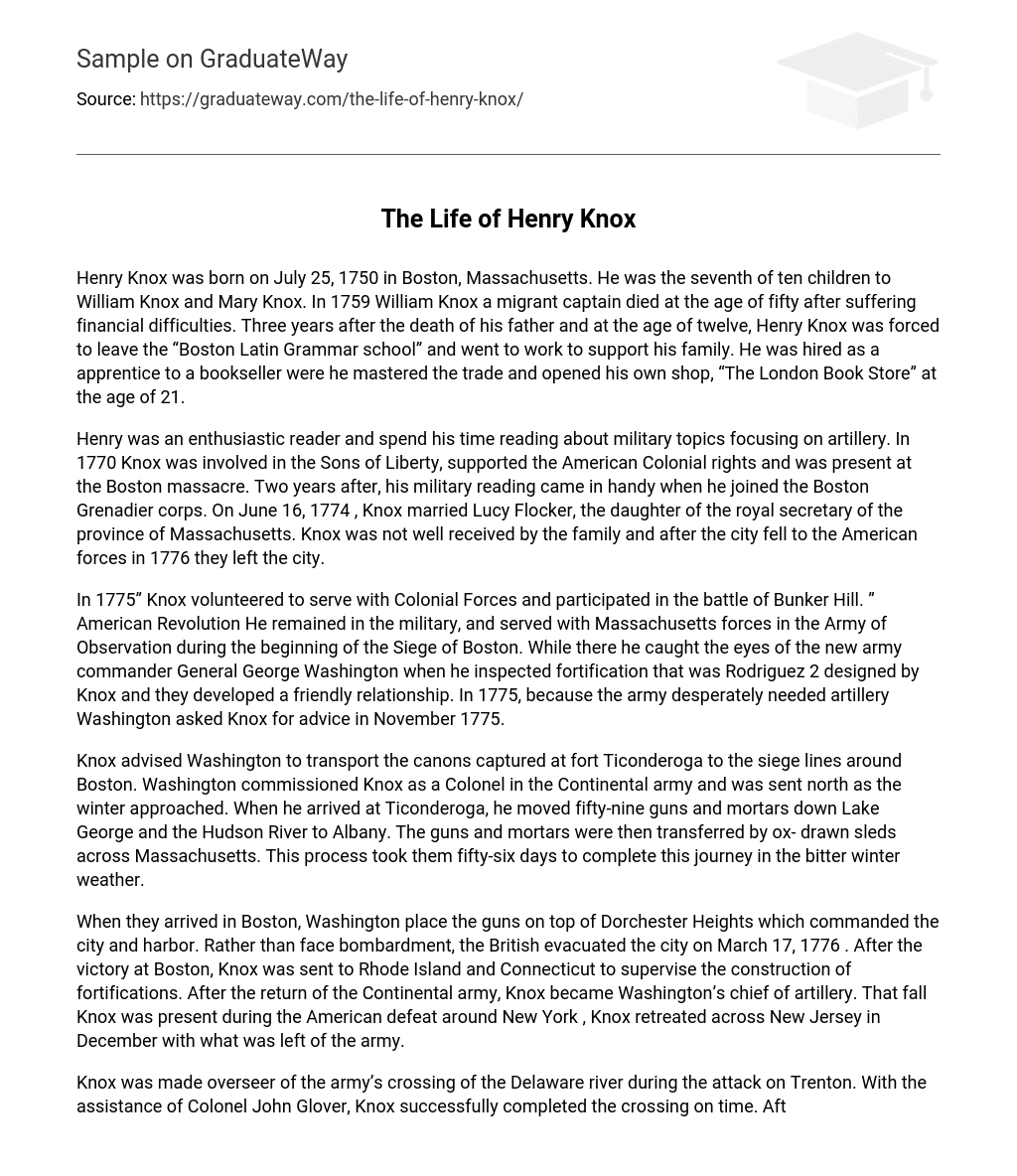Henry Knox, born on July 25, 1750 in Boston, Massachusetts, was the seventh child of William and Mary Knox. Tragically, his father passed away when he was only nine years old due to financial difficulties. As a result, Henry had to quit “Boston Latin Grammar school” at the age of twelve and start working to support his family. Thankfully, he secured an apprenticeship with a bookseller and eventually established his own shop named “The London Book Store” by the time he turned twenty-one.
Henry Knox, a devoted reader, dedicated his time to studying military subjects, specifically artillery. In 1770, he joined the Sons of Liberty and actively supported the rights of American Colonists. During this period, he witnessed the Boston Massacre. Two years later, his extensive knowledge of military literature proved invaluable as he became a member of the Boston Grenadier Corps. On June 16, 1774, he married Lucy Flocker, daughter of the royal secretary of Massachusetts province – although her family did not warmly welcome him. However, in 1776 when American forces took control of the city, they departed together with their family.
In 1775, Knox joined the Colonial Forces and fought in the battle of Bunker Hill during the American Revolution. He continued his military service with Massachusetts forces and was part of the Army of Observation at the beginning of the Siege of Boston. It was during this time that General George Washington noticed a fortification built by Knox, which resulted in a friendly relationship between them. In November 1775, Washington requested Knox’s assistance in artillery due to the army’s immediate needs.
Knox recommended that the cannons seized at fort Ticonderoga be brought to the siege lines in Boston. Washington appointed Knox as a Colonel in the Continental army and sent him north during the winter. Upon reaching Ticonderoga, Knox transported fifty-nine guns and mortars via Lake George and the Hudson River to Albany. From there, the cannons were transferred by sleds pulled by oxen across Massachusetts. It took them fifty-six days to successfully complete this arduous journey in the harsh winter conditions.
When they arrived in Boston, Washington positioned the guns on top of Dorchester Heights, which had a strategic advantage over the city and harbor. As a result, instead of facing bombardment, the British chose to evacuate the city on March 17, 1776. Following the successful outcome in Boston, Knox was assigned to oversee the construction of fortifications in Rhode Island and Connecticut. After the Continental army returned, Knox assumed the role of Washington’s chief of artillery. In the autumn, Knox was present during the American defeat near New York and subsequently retreated across New Jersey in December with the remaining army forces.
Knox was appointed as overseer of the army’s Delaware river crossing during the attack on Trenton, with the help of Colonel John Glover facilitating the successful completion of the crossing. Following this accomplishment, Knox was elevated to Brigadier General. During the winter break, he came back to Massachusetts and devised a strategy to enhance weapons manufacturing. He journeyed to Springfield armory and became a crucial contributor to the production of American weapons for nearly two centuries.
In winter at Valley Forge, Knox assisted in securing supplies and helped Baron von Steuben drill the troops. He was then sent north for two years to secure supplies for the army. In 1780, he also served on the court-martial of British spy Major John Andre. Knox’s guns played a crucial role in the attacks on General Lord Charles Cornwallis at Yorktown, VA. After the victory, he was promoted to Major General and assigned to command American forces at West Point. He also led the formation of the Society of Cincinnati during this assignment.
After the war ended in 1783, Knox led his troops to New York City and took control from the departing British. When Washington resigned, Knox became the Senior Officer of the Continental Army on December 23, 1783. He held this role until he retired in 1784. Soon after retiring, he was appointed by the Continental Congress as Secretary of War on March 8, 1785. He expressed his support for the new Constitution and remained Secretary of War in George Washington’s first cabinet in 1789.
He supervised the establishment of a permanent navy, national militia, and coastal fortifications. On January 2, 1795, Knox left his position as Secretary of War to focus on personal matters and family. He retired at “Montpelia” estate in Thomaston, Maine. During retirement, he engaged in various business ventures and later represented the town in the Massachusetts General Assembly. Sadly, Knox died on October 25, 1806 due to peritonitis caused by accidentally swallowing a chicken bone three days prior.





